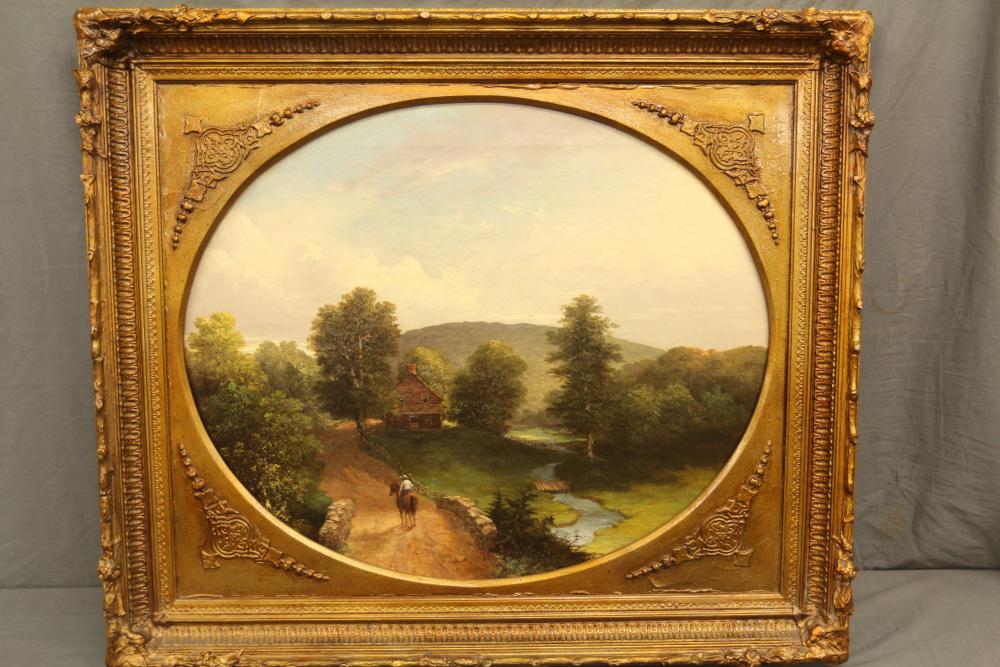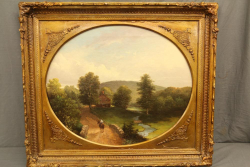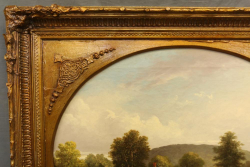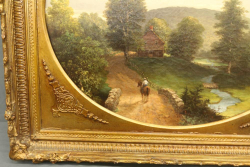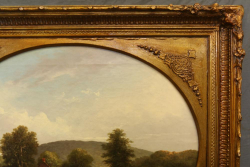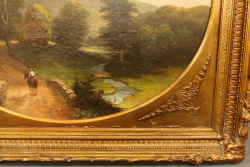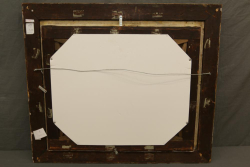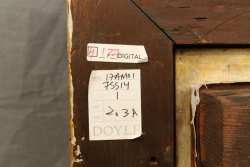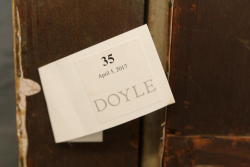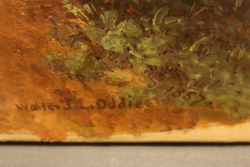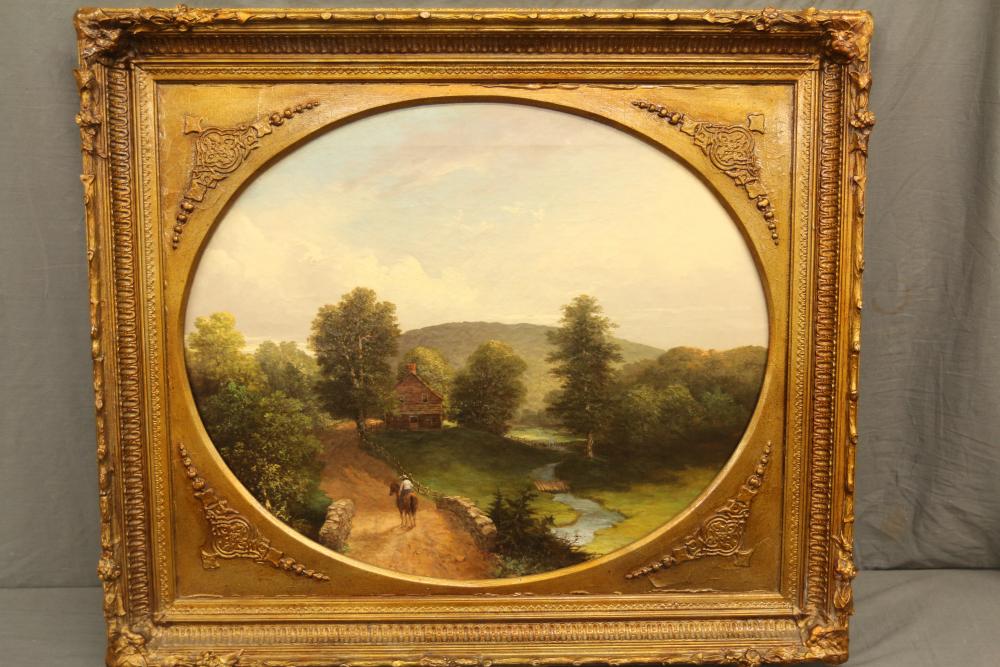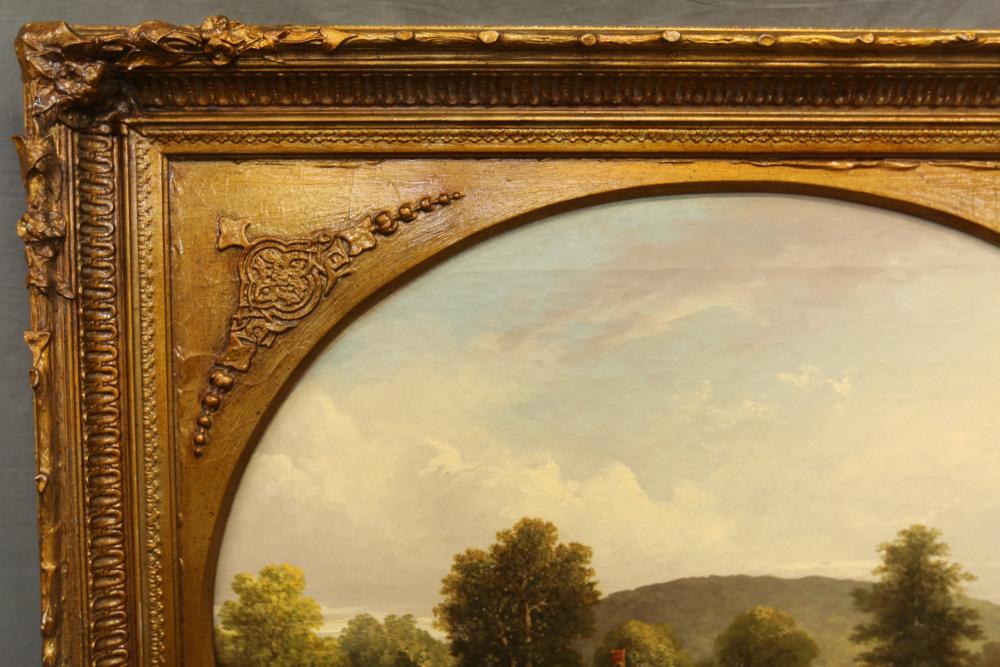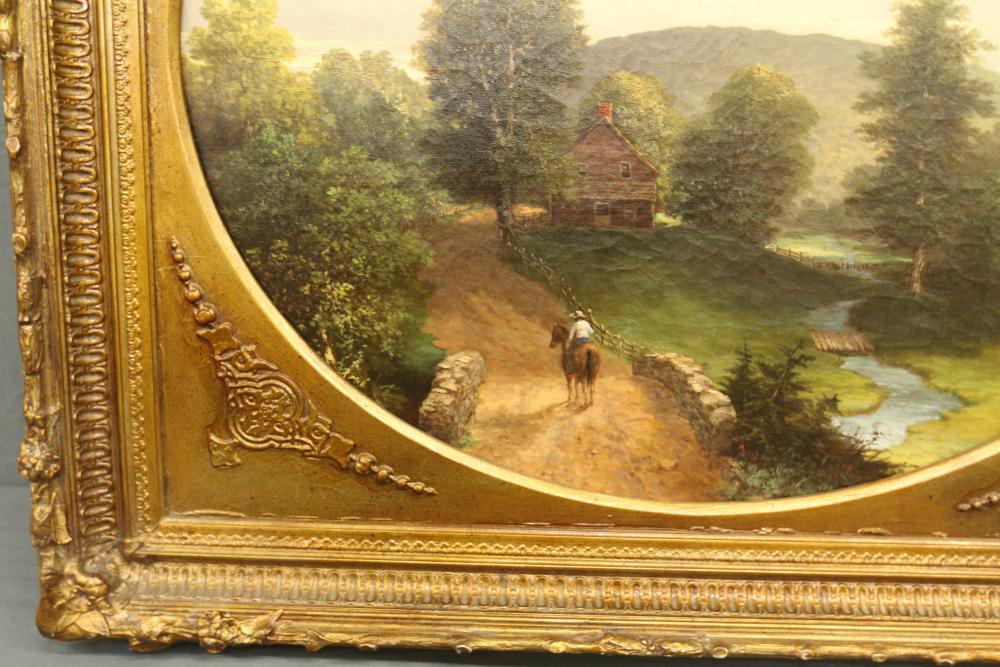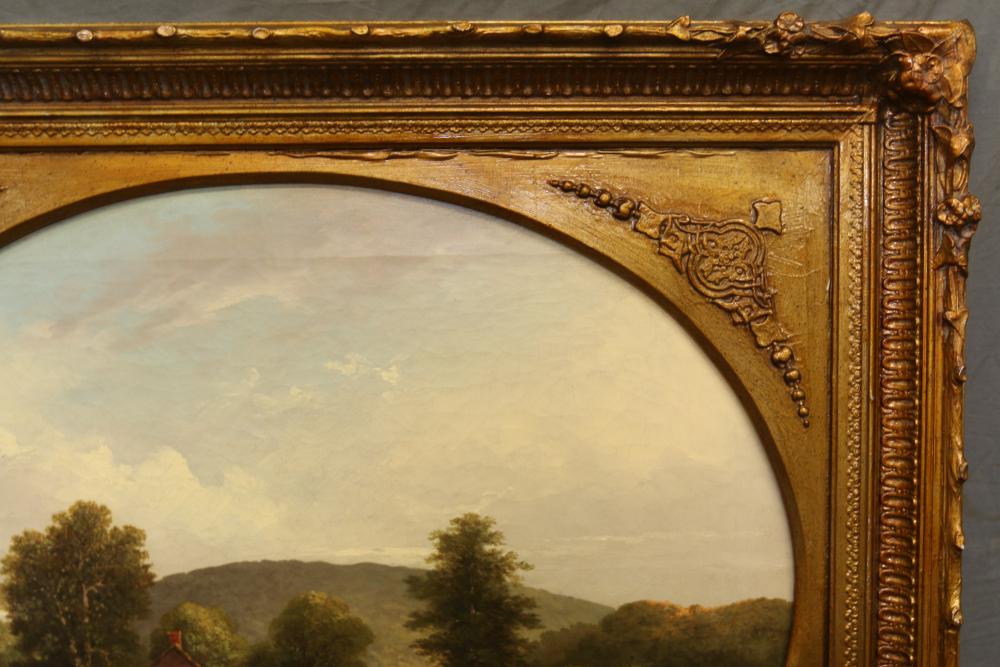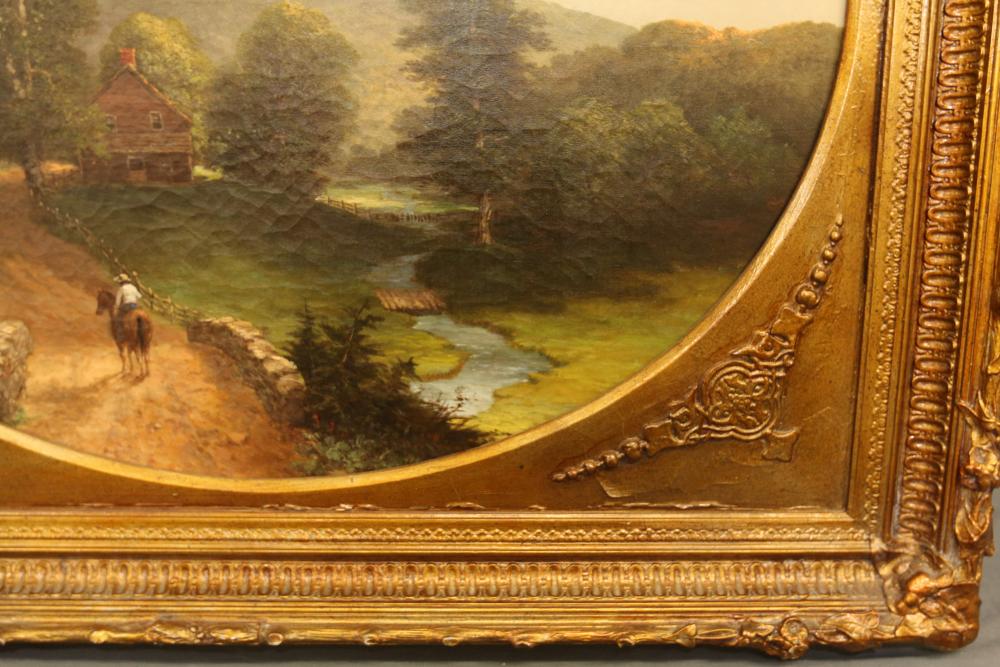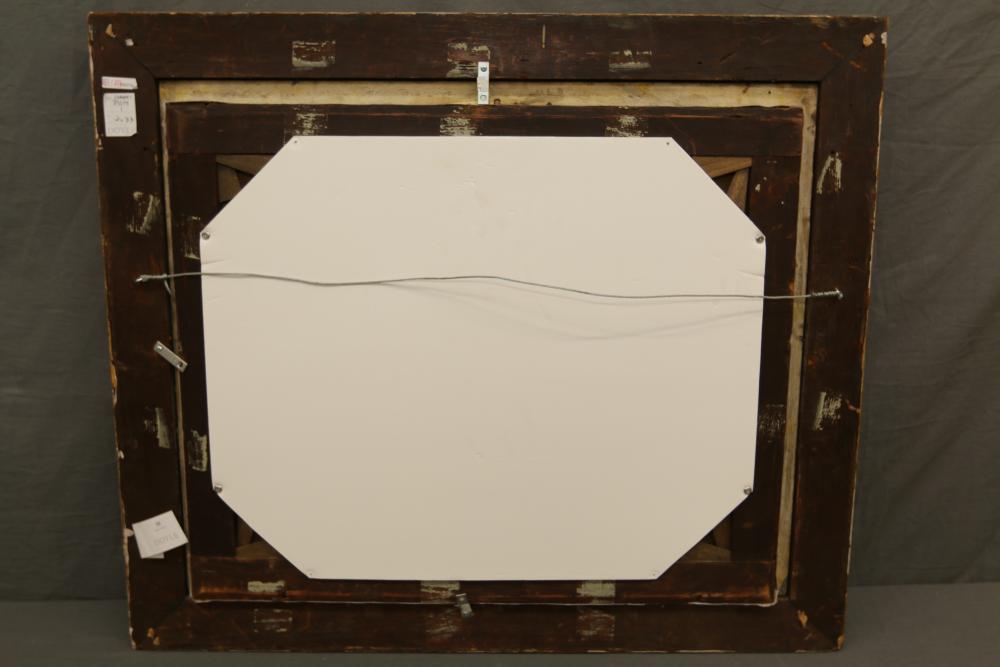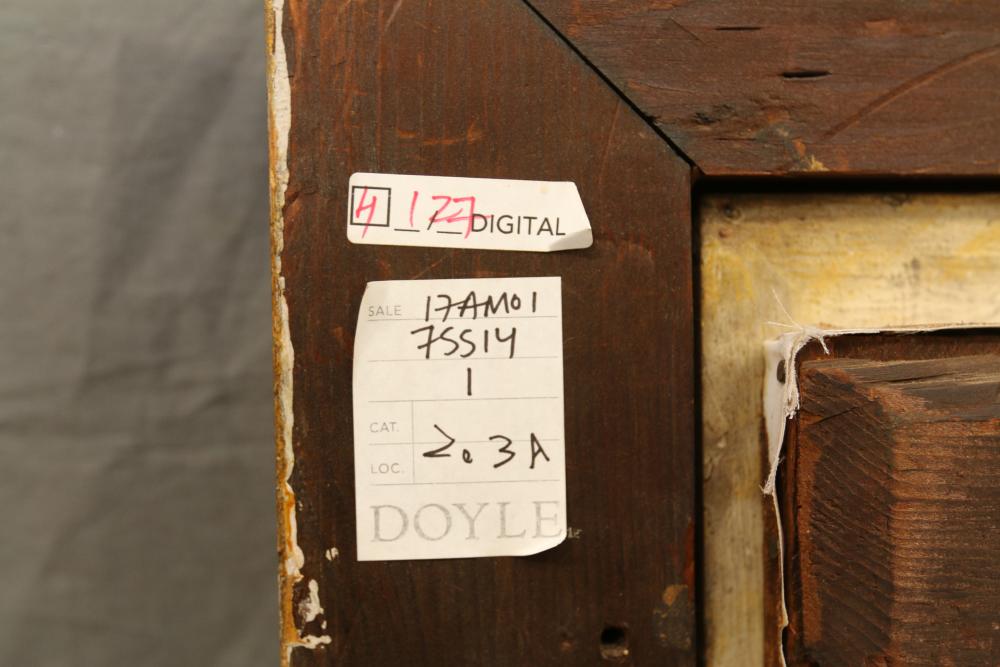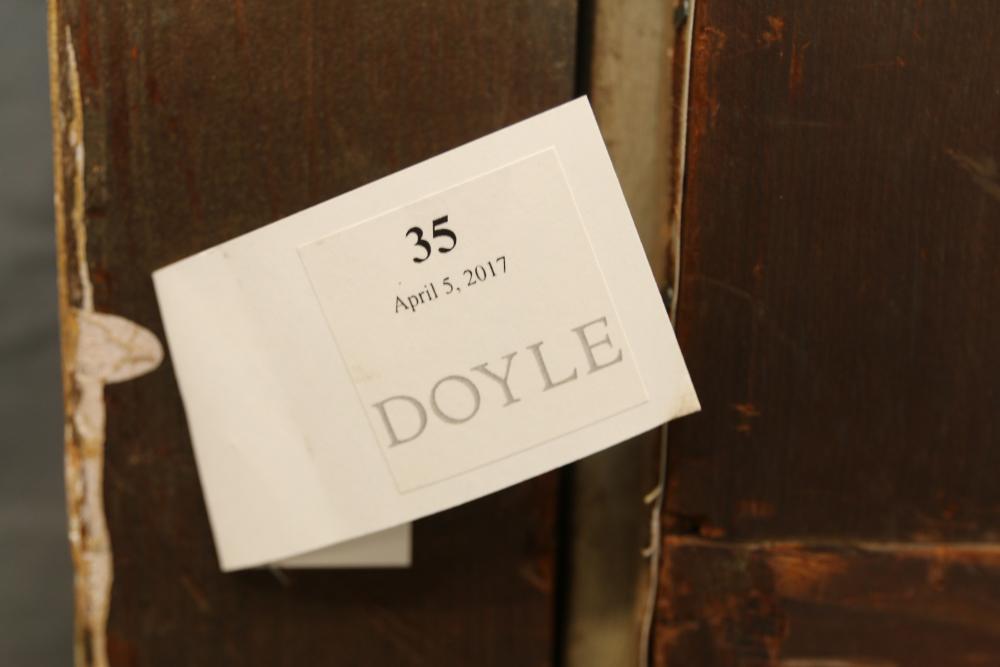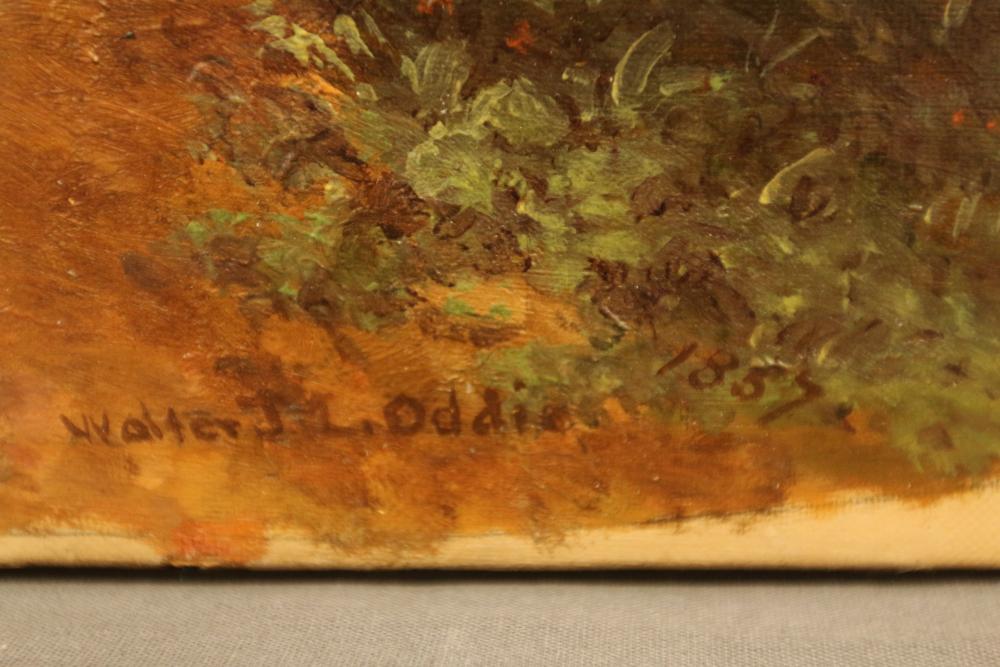Auctioneer's Note: The first American School of Art is known as ''The Hudson River School,'' consisting of mid-nineteenth century ''Nature Painters'' who found spirituality in nature. These adventuresome artists hiked to see impressive views. They sketched and did studies in the field to bring back to their studios where they would create the finished paintings. The Hudson River served as the main route of travel to the best places, as well as provided the best subject matter. New York City, with the National Academy of Design to exhibit at, was the center of the American Arts world in the 19thC. Now you can bid on 69 lots of paintings and prints, mostly related to the Hudson Valley. Today, with an emphasis on conservation of resources, and going ''Green,''it is the best time to purchase and enjoy these beautiful works. Bidding is online, with the opportunity to preview at the Absolute Auction Center. Every lot starts at $1.00 and sells to the highest bidder. Good luck! - Rob Doyle. Items located in Pleasant Valley, NY.
Payment is due by Thursday, February 27 at 1PM.
Pickup in Pleasant Valley, NY must be completed by Thursday, February 27 at 3PM.
All lots sold as is, where is. There is a 15% Buyers Premium for all lots purchased. Payment methods for non-vehicles & non-equipment include cash, MC, Visa, Discover or good check. Payment method for vehicles & equipment is cash, cashiers check, money order or wire transfer only, no exceptions. You can make credit card payment online by going to "My Account" and selecting your invoice.
Preview available Monday-Friday 9am-3pm by appointment only or online 24 hours. Use this link to get directions to the Absolute Auction Center: http://mapq.st/1wgg9jz
** NOTE: Shipping is available on all items with proper identification.**
Click More Info/Bid Now for additional photos.
Payment is due by Thursday, February 27 at 1PM.
Pickup in Pleasant Valley, NY must be completed by Thursday, February 27 at 3PM.
All lots sold as is, where is. There is a 15% Buyers Premium for all lots purchased. Payment methods for non-vehicles & non-equipment include cash, MC, Visa, Discover or good check. Payment method for vehicles & equipment is cash, cashiers check, money order or wire transfer only, no exceptions. You can make credit card payment online by going to "My Account" and selecting your invoice.
Preview available Monday-Friday 9am-3pm by appointment only or online 24 hours. Use this link to get directions to the Absolute Auction Center: http://mapq.st/1wgg9jz
** NOTE: Shipping is available on all items with proper identification.**
Click More Info/Bid Now for additional photos.
Auction Info
Auctioneer's Note: The first American School of Art is known as ''The Hudson River School,'' consisting of mid-nineteenth century ''Nature Painters'' who found spirituality in nature. These adventuresome artists hiked to see impressive views. They sketched and did studies in the field to bring back to their studios where they would create the finished paintings. The Hudson River served as the main route of travel to the best places, as well as provided the best subject matter. New York City, with the National Academy of Design to exhibit at, was the center of the American Arts world in the 19thC. Now you can bid on 69 lots of paintings and prints, mostly related to the Hudson Valley. Today, with an emphasis on conservation of resources, and going ''Green,''it is the best time to purchase and enjoy these beautiful works. Bidding is online, with the opportunity to preview at the Absolute Auction Center. Every lot starts at $1.00 and sells to the highest bidder. Good luck! - Rob Doyle. Items located in Pleasant Valley, NY.
Payment is due by Thursday, February 27 at 1PM.
Pickup in Pleasant Valley, NY must be completed by Thursday, February 27 at 3PM.
All lots sold as is, where is. There is a 15% Buyers Premium for all lots purchased. Payment methods for non-vehicles & non-equipment include cash, MC, Visa, Discover or good check. Payment method for vehicles & equipment is cash, cashiers check, money order or wire transfer only, no exceptions. You can make credit card payment online by going to "My Account" and selecting your invoice.
Preview available Monday-Friday 9am-3pm by appointment only or online 24 hours. Use this link to get directions to the Absolute Auction Center: http://mapq.st/1wgg9jz
** NOTE: Shipping is available on all items with proper identification.**
Click More Info/Bid Now for additional photos.
Payment is due by Thursday, February 27 at 1PM.
Pickup in Pleasant Valley, NY must be completed by Thursday, February 27 at 3PM.
All lots sold as is, where is. There is a 15% Buyers Premium for all lots purchased. Payment methods for non-vehicles & non-equipment include cash, MC, Visa, Discover or good check. Payment method for vehicles & equipment is cash, cashiers check, money order or wire transfer only, no exceptions. You can make credit card payment online by going to "My Account" and selecting your invoice.
Preview available Monday-Friday 9am-3pm by appointment only or online 24 hours. Use this link to get directions to the Absolute Auction Center: http://mapq.st/1wgg9jz
** NOTE: Shipping is available on all items with proper identification.**
Click More Info/Bid Now for additional photos.
Categories:
His place of birth is variously reported as Maryland or Washington, DC, or possibly New Orleans, Louisiana, where his father lived before moving permanently to New York. Walter Mason Oddie was the son of Cornelia Wattles (1784-1821) and John Ward Oddie (1772-1865). John Oddie was a merchant and native of Great Britain and arrived in the United States around 1800, while Cornelia Wattles was the daughter of Major Mason Wattles (1752-1819), who served in the continental army during the American Revolution.
Walter Oddie married Julia Austin Meigs (1806-1892), the daughter of the Honorable Henry Meigs (1782-1861), the U. S. congressman, alderman, and judge from New York. Together they had at least seven children between 1832 and 1850, including Orville Oddie (b. 1833), the New York banker and broker. According to William Dunlap, author and compiler of A History of the Rise and Progress of the Arts of Design in the United States (1918), Oddie first became interested in art through watching his father-in-law sketch. This, according to Dunlap, “...first induced our friend Oddie to try his hand [at art].''
After a period of self-study, Oddie eventually became a student of the American Hudson River School painter Robert Walter Weir (1803-1889), and of Anthony Lewis De Rose (1803-1836), the New York portrait and historical painter. Like so many artists of the period, he did not follow the profession of painter solely, rather he divided his time between being an artist and a merchant, though it seems he was never really that successful during his lifetime as either (he was declared bankrupt as a broker in 1843). In his surviving diaries, he notes how the issue of money overshadowed his life, “I shall know no peace of mind until I am once more free from the turmoils of debt — and stand independent of the world as far as relates to obligation.'' It seems he devoted himself more fully to painting after his final business troubles in the early 1840s.
Walter Oddie began exhibiting his paintings at the National Academy of Design in Manhattan in 1832 and was quickly raised just a year later to the honor of Associate of the National Academy (A.N.A.). At his debut at the Academy in 1832 one contemporary critic commented that “He seems to have a passion for the thousand quiet nooks...and he portrays nature as she appears in her everyday garb...'' Three years later (1835) The American Monthly Magazine commented upon Oddie’s submissions to that year’s Academy exhibition:
“The views of this artist are possessed of very decided merit-great strength, colors in general natural, perspective good-on the other hand we must confess that his figures do not, by any means, come up to his inanimate nature, and that his skies are at times somewhat harsh-these faults we are willing to designate to Mr. Oddie, because, barring these, he might, and probably will, become a firstrate artist.''
At the 1836 Academy exhibition, The Knickerbocker Magazine remarked negatively that his submission was “...one unnatural mass of green, without light or shade,'' but by the time of the 1837 exhibition his painting entitled “Landscape,'' was heaped with praise by the same publication:
“A perfect contrast to the preceding work [by C. C. Ingham]. That is all minuteness and delicacy, this all freedom and general effect. There is a world of industry and professional knowledge in the first, yet we confess that to our taste there is more of the artist in the second. Mr. Ingham’s work landscape is astonishingly beautiful, but to our mind Mr. Oddie’s is the most pleasing, because [it is] most like nature.''
And at the 1840 Academy exhibition, The Knickerbocker Magazine returned again with high praise, and a bit of worry: “Our artist should not suffer his pencil to lie so idle. We see but few of his efforts lately. He paints too well to abandon the art.'' The publication The American Repertory of Arts, Sciences, and Manufactures also remarked that year that “Mr. Oddie is an amateur artist, and produces pictures that would do credit to many professionals.''
During the next twenty-five years he exhibited numerous canvases at the National Academy, nearly all of them depicting unidentified landscapes. Only four of his paintings exhibited at the Academy had more specific titles, “Italian Coast Scene,'' “Sea Coast,'' “Bay Scene, Long Island,'' and a final work, exhibited in 1859, which was entitled “Evening, Allegany Mts., West Virginia.''
The last work is intriguing, as it indicates that Oddie may have been part of a group of artists that traveled to the western part of Virginia (not yet the independent state of West Virginia) in 1858 to document and illustrate scenes for the Baltimore & Ohio Railroad. The known members of the group included the artists Asher B. Durand (1796-1886), Thomas Hicks (1823-1890), Thomas Rossiter (1818-1871), the artist and writer David Hunter Strother (1816-1888), and the New York Times editor Henry Jarvis Raymond (1820-1869). The current whereabouts of Oddie’s West Virginia work remains unknown.
Soon after he began exhibiting at the Academy Oddie also started exhibiting with the Apollo Association, which was in existence from 1839 through 1844 when its name change to the American Art Union became official. In 1842 he exhibited the paintings “Landscape,'' “Road Scene,'' “View of an Old Mill at Tappan,'' and “View Near Jamaica, Long Island.'' He exhibited with the group again in 1844, when he submitted the works “Pine Brook, New Jersey'' and “Wood Scene, Spanish.'' The New Jersey scene was one of several apparently created following visits to the Somerset County region of the state, as noted in Volume 24 of the journal, The New Jersey Historical Series.
His submissions to the American Art Union, which occurred between 1847 and 1852, included landscapes again. At the 1847 exhibition two works, “Bay Scene'' and “Coast Scene'' were included for display and at the 1848 exhibition, of the fourteen works Oddie exhibited only one had a title other than “Landscape,'' and that was the work “Caldwell’s Landing-Sunset,'' which depicted a scene located along the Hudson River near Sloatsburg in Rockland County, New York. In 1849 he showed the work “Landscape-Brook Scene,'' in addition to five works simply titled “Landscape'' and in 1850 the work “A Mountain Stream'' was shown in addition to four works simply titled “Landscape.'' At the 1851 exhibition and sale a work entitled “View on the Housatonic,'' a Connecticut scene, was shown, as was the work “Scene Near Lenox, Massachusetts,'' which was listed as an unusual, circular painting. Eight additional generically titled works-“Cascade,'' “Coast Scene,'' “Meadow Scope,'' “Moonlight,'' “Mountain Torrent,'' “Saw Mills,'' “Stony Brook,'' (probably not the Long Island village), and “Trout Brook'' were also included in the 1851 sale. The following year, at the 1852 sale dispersing the Union’s collection, the similarly titled (or possibly the same) scenes “Scene Near Lenox, Mass.'' and “View on the Housatonic'' were sold as was a painting of the Delaware River. His works in the 1852 exhibition were commented upon in the New York Times, which noted “There were some fine landscape works by Oddie... for which there was some competition.''
By the mid 1850’s Walter Oddie had joined other Hudson River School painters working in the Kaaterskill Clove, as noted in Kenneth Myers The Catskills: Painters, Writers, and Tourists in the Mountains, 1820-1895, and was also working near Lake George, but his trips would soon become fewer and fewer. Oddie would soon be suffering from digestive problems which made it very difficult for him to work for long stretches of time. This may explain the several years later in his life during which he did not regularly exhibit at the National Academy or anywhere else. In his last years he lived in Bedford, part of Brooklyn on Long Island.
Walter Mason Oddie died suddenly on Friday, the 15th of November 1865 in Brooklyn, Long Island, New York at the age of 57 years. His funeral service was held from his home, located at the corner Gates and Grand Avenues that afternoon, with burial following in Lot 18458, Section 115 of Greenwood Cemetery, located in Brooklyn, Kings County, New York.
While he was known to be a teacher, few of his students are known to us today. Among them was a young Edward Lamson Henry (1841-1919), who began studying with Oddie during the mid-1850s in New York. Early in his life, in 1828, Oddie wrote about and sketched the famous 19th century American daredevil, Sam Patch (1799-1829), when he jumped from Paterson Falls at Hoboken, New Jersey. At least one of his drawings, “Hudson Highlands,'' was turned into an engraving by J. Duthie and was later used to illustrate Washington Irving’s The Legend of Sleepy Hollow, and The Spectre Bridegroom, published by J.B. Lippincott & Company in 1875.
Numerous exhibition sized oils by Oddie have come up at auction during the past two decades. Many are fully signed and dated, though few have original titles and therefore are nearly impossible to identify as to exact location and subject. To further complicate matters several contemporary auction houses have utilized or added titles based on the appearance of the works themselves, many of which may be inaccurate as they have often been created without anything to guarantee the location or subject. One identified work, entitled “Susquehanna River, Near Binghamton,'' shows that Oddie may have traveled to that part of New York State to paint. He also worked in Connecticut, where his paintings “Housatonic River'' and “Landscape scene on the Connecticut [River]'' were painted. Additionally, identified scenes of Massachusetts, New Jersey, and Long Island (as mentioned above) were also exhibited during his lifetime. Reginald E. Nickerson
The paintings created by Oddie are typical of the Hudson River School tradition and include expansive landscapes and the occasional coastal work. They often include mountains and lakes, as well as people who are dwarfed by the huge landscapes in which they find themselves. The paintings do not have a thick impasto, but often have very flat surfaces. According to William Dunlap, the somewhat barren appearance of Oddie’s early landscapes was due to his inability to depict trees well. His works are usually dated and fully signed, “Walter M. Oddie,'' though a few early works are simply monogrammed “W.M.O.'' Paintings that came through the American Art Union sales often have period labels glued to their stretchers, and at least two of his paintings from the Union’s exhibition of 1849 surfaced at auction in 2011 and 2015.
In addition to being an artist, Oddie also was a collector of his fellow painters creations. Among the most notable work he acquired (by 1838) was Robert Walter Weir’s masterpiece, the “Greenwich Boat Club'' (1833). This work depicts members of the “Boat Club,'' of which Oddie was a member, as Sotheby’s noted when the work was sold at auction in 2008:
“The "Boat Club" refers to a group of friends that included Walter M. Oddie, an artist and informal student of Weir's... [and] it is likely that Weir's inspiration for the painting was derived from several similar outings made by the group. The men depicted likely include artists Oddie, George Miller, doctors William Draper Brincklé and James Ellsworth DeKay, poet Fitz-Greene Halleck, the guitarist known as Martinez, and Henry Meigs, Oddie's brother-in-law. Weir may have included himself in the center of the image, near the pole. Several of the men, including Weir, belonged to the Sketch Club, an informal salon formed in the 1820s. The appearance of the New York coastline in the distance suggests that the party spent the day on the shores of New Jersey. The men have turned the boat, which probably belonged to Oddie, on its side and fashioned a tent out of the sail.''
While there are undoubtedly other exhibitions in which Oddie participated, those presently known include the following: National Academy of Design, New York, NY, 1832-42, 1846-47, 1849, 1853, 1859 (WV scene); Apollo Association, New York, NY, 1842, 1844; American Art Union, New York, NY, 1847-52; Pennsylvania Academy of the Fine Arts, Philadelphia, PA, 1852, 1855; Brooklyn Art Association, Brooklyn, NY, 1863, 1879 (posthumous); The Washington Art Association, Washington, DC, c. 1856-60; Boston Athenaeum, Boston, MA, (u.d.); Brooklyn Institute, Brooklyn, NY, (u.d.).
His works are known to be held in the following public institutions: Albany Institute of History and Art, Albany, NY; Corcoran Gallery of Art, Washington, DC; Forbes Magazine Collection, New York, NY; Newark Museum, Newark, NJ; New York Historical Society, New York, NY; Reading Public Museum, Reading, PA; and the Winterthur Museum, Winterthur, DE. The majority of his works reside in private collections throughout the United States. (His paintings have sold for as high as $12,650.)
More Details
His place of birth is variously reported as Maryland or Washington, DC, or possibly New Orleans, Louisiana, where his father lived before moving permanently to New York. Walter Mason Oddie was the son of Cornelia Wattles (1784-1821) and John Ward Oddie (1772-1865). John Oddie was a merchant and native of Great Britain and arrived in the United States around 1800, while Cornelia Wattles was the daughter of Major Mason Wattles (1752-1819), who served in the continental army during the American Revolution.
Walter Oddie married Julia Austin Meigs (1806-1892), the daughter of the Honorable Henry Meigs (1782-1861), the U. S. congressman, alderman, and judge from New York. Together they had at least seven children between 1832 and 1850, including Orville Oddie (b. 1833), the New York banker and broker. According to William Dunlap, author and compiler of A History of the Rise and Progress of the Arts of Design in the United States (1918), Oddie first became interested in art through watching his father-in-law sketch. This, according to Dunlap, “...first induced our friend Oddie to try his hand [at art].''
After a period of self-study, Oddie eventually became a student of the American Hudson River School painter Robert Walter Weir (1803-1889), and of Anthony Lewis De Rose (1803-1836), the New York portrait and historical painter. Like so many artists of the period, he did not follow the profession of painter solely, rather he divided his time between being an artist and a merchant, though it seems he was never really that successful during his lifetime as either (he was declared bankrupt as a broker in 1843). In his surviving diaries, he notes how the issue of money overshadowed his life, “I shall know no peace of mind until I am once more free from the turmoils of debt — and stand independent of the world as far as relates to obligation.'' It seems he devoted himself more fully to painting after his final business troubles in the early 1840s.
Walter Oddie began exhibiting his paintings at the National Academy of Design in Manhattan in 1832 and was quickly raised just a year later to the honor of Associate of the National Academy (A.N.A.). At his debut at the Academy in 1832 one contemporary critic commented that “He seems to have a passion for the thousand quiet nooks...and he portrays nature as she appears in her everyday garb...'' Three years later (1835) The American Monthly Magazine commented upon Oddie’s submissions to that year’s Academy exhibition:
“The views of this artist are possessed of very decided merit-great strength, colors in general natural, perspective good-on the other hand we must confess that his figures do not, by any means, come up to his inanimate nature, and that his skies are at times somewhat harsh-these faults we are willing to designate to Mr. Oddie, because, barring these, he might, and probably will, become a firstrate artist.''
At the 1836 Academy exhibition, The Knickerbocker Magazine remarked negatively that his submission was “...one unnatural mass of green, without light or shade,'' but by the time of the 1837 exhibition his painting entitled “Landscape,'' was heaped with praise by the same publication:
“A perfect contrast to the preceding work [by C. C. Ingham]. That is all minuteness and delicacy, this all freedom and general effect. There is a world of industry and professional knowledge in the first, yet we confess that to our taste there is more of the artist in the second. Mr. Ingham’s work landscape is astonishingly beautiful, but to our mind Mr. Oddie’s is the most pleasing, because [it is] most like nature.''
And at the 1840 Academy exhibition, The Knickerbocker Magazine returned again with high praise, and a bit of worry: “Our artist should not suffer his pencil to lie so idle. We see but few of his efforts lately. He paints too well to abandon the art.'' The publication The American Repertory of Arts, Sciences, and Manufactures also remarked that year that “Mr. Oddie is an amateur artist, and produces pictures that would do credit to many professionals.''
During the next twenty-five years he exhibited numerous canvases at the National Academy, nearly all of them depicting unidentified landscapes. Only four of his paintings exhibited at the Academy had more specific titles, “Italian Coast Scene,'' “Sea Coast,'' “Bay Scene, Long Island,'' and a final work, exhibited in 1859, which was entitled “Evening, Allegany Mts., West Virginia.''
The last work is intriguing, as it indicates that Oddie may have been part of a group of artists that traveled to the western part of Virginia (not yet the independent state of West Virginia) in 1858 to document and illustrate scenes for the Baltimore & Ohio Railroad. The known members of the group included the artists Asher B. Durand (1796-1886), Thomas Hicks (1823-1890), Thomas Rossiter (1818-1871), the artist and writer David Hunter Strother (1816-1888), and the New York Times editor Henry Jarvis Raymond (1820-1869). The current whereabouts of Oddie’s West Virginia work remains unknown.
Soon after he began exhibiting at the Academy Oddie also started exhibiting with the Apollo Association, which was in existence from 1839 through 1844 when its name change to the American Art Union became official. In 1842 he exhibited the paintings “Landscape,'' “Road Scene,'' “View of an Old Mill at Tappan,'' and “View Near Jamaica, Long Island.'' He exhibited with the group again in 1844, when he submitted the works “Pine Brook, New Jersey'' and “Wood Scene, Spanish.'' The New Jersey scene was one of several apparently created following visits to the Somerset County region of the state, as noted in Volume 24 of the journal, The New Jersey Historical Series.
His submissions to the American Art Union, which occurred between 1847 and 1852, included landscapes again. At the 1847 exhibition two works, “Bay Scene'' and “Coast Scene'' were included for display and at the 1848 exhibition, of the fourteen works Oddie exhibited only one had a title other than “Landscape,'' and that was the work “Caldwell’s Landing-Sunset,'' which depicted a scene located along the Hudson River near Sloatsburg in Rockland County, New York. In 1849 he showed the work “Landscape-Brook Scene,'' in addition to five works simply titled “Landscape'' and in 1850 the work “A Mountain Stream'' was shown in addition to four works simply titled “Landscape.'' At the 1851 exhibition and sale a work entitled “View on the Housatonic,'' a Connecticut scene, was shown, as was the work “Scene Near Lenox, Massachusetts,'' which was listed as an unusual, circular painting. Eight additional generically titled works-“Cascade,'' “Coast Scene,'' “Meadow Scope,'' “Moonlight,'' “Mountain Torrent,'' “Saw Mills,'' “Stony Brook,'' (probably not the Long Island village), and “Trout Brook'' were also included in the 1851 sale. The following year, at the 1852 sale dispersing the Union’s collection, the similarly titled (or possibly the same) scenes “Scene Near Lenox, Mass.'' and “View on the Housatonic'' were sold as was a painting of the Delaware River. His works in the 1852 exhibition were commented upon in the New York Times, which noted “There were some fine landscape works by Oddie... for which there was some competition.''
By the mid 1850’s Walter Oddie had joined other Hudson River School painters working in the Kaaterskill Clove, as noted in Kenneth Myers The Catskills: Painters, Writers, and Tourists in the Mountains, 1820-1895, and was also working near Lake George, but his trips would soon become fewer and fewer. Oddie would soon be suffering from digestive problems which made it very difficult for him to work for long stretches of time. This may explain the several years later in his life during which he did not regularly exhibit at the National Academy or anywhere else. In his last years he lived in Bedford, part of Brooklyn on Long Island.
Walter Mason Oddie died suddenly on Friday, the 15th of November 1865 in Brooklyn, Long Island, New York at the age of 57 years. His funeral service was held from his home, located at the corner Gates and Grand Avenues that afternoon, with burial following in Lot 18458, Section 115 of Greenwood Cemetery, located in Brooklyn, Kings County, New York.
While he was known to be a teacher, few of his students are known to us today. Among them was a young Edward Lamson Henry (1841-1919), who began studying with Oddie during the mid-1850s in New York. Early in his life, in 1828, Oddie wrote about and sketched the famous 19th century American daredevil, Sam Patch (1799-1829), when he jumped from Paterson Falls at Hoboken, New Jersey. At least one of his drawings, “Hudson Highlands,'' was turned into an engraving by J. Duthie and was later used to illustrate Washington Irving’s The Legend of Sleepy Hollow, and The Spectre Bridegroom, published by J.B. Lippincott & Company in 1875.
Numerous exhibition sized oils by Oddie have come up at auction during the past two decades. Many are fully signed and dated, though few have original titles and therefore are nearly impossible to identify as to exact location and subject. To further complicate matters several contemporary auction houses have utilized or added titles based on the appearance of the works themselves, many of which may be inaccurate as they have often been created without anything to guarantee the location or subject. One identified work, entitled “Susquehanna River, Near Binghamton,'' shows that Oddie may have traveled to that part of New York State to paint. He also worked in Connecticut, where his paintings “Housatonic River'' and “Landscape scene on the Connecticut [River]'' were painted. Additionally, identified scenes of Massachusetts, New Jersey, and Long Island (as mentioned above) were also exhibited during his lifetime. Reginald E. Nickerson
The paintings created by Oddie are typical of the Hudson River School tradition and include expansive landscapes and the occasional coastal work. They often include mountains and lakes, as well as people who are dwarfed by the huge landscapes in which they find themselves. The paintings do not have a thick impasto, but often have very flat surfaces. According to William Dunlap, the somewhat barren appearance of Oddie’s early landscapes was due to his inability to depict trees well. His works are usually dated and fully signed, “Walter M. Oddie,'' though a few early works are simply monogrammed “W.M.O.'' Paintings that came through the American Art Union sales often have period labels glued to their stretchers, and at least two of his paintings from the Union’s exhibition of 1849 surfaced at auction in 2011 and 2015.
In addition to being an artist, Oddie also was a collector of his fellow painters creations. Among the most notable work he acquired (by 1838) was Robert Walter Weir’s masterpiece, the “Greenwich Boat Club'' (1833). This work depicts members of the “Boat Club,'' of which Oddie was a member, as Sotheby’s noted when the work was sold at auction in 2008:
“The "Boat Club" refers to a group of friends that included Walter M. Oddie, an artist and informal student of Weir's... [and] it is likely that Weir's inspiration for the painting was derived from several similar outings made by the group. The men depicted likely include artists Oddie, George Miller, doctors William Draper Brincklé and James Ellsworth DeKay, poet Fitz-Greene Halleck, the guitarist known as Martinez, and Henry Meigs, Oddie's brother-in-law. Weir may have included himself in the center of the image, near the pole. Several of the men, including Weir, belonged to the Sketch Club, an informal salon formed in the 1820s. The appearance of the New York coastline in the distance suggests that the party spent the day on the shores of New Jersey. The men have turned the boat, which probably belonged to Oddie, on its side and fashioned a tent out of the sail.''
While there are undoubtedly other exhibitions in which Oddie participated, those presently known include the following: National Academy of Design, New York, NY, 1832-42, 1846-47, 1849, 1853, 1859 (WV scene); Apollo Association, New York, NY, 1842, 1844; American Art Union, New York, NY, 1847-52; Pennsylvania Academy of the Fine Arts, Philadelphia, PA, 1852, 1855; Brooklyn Art Association, Brooklyn, NY, 1863, 1879 (posthumous); The Washington Art Association, Washington, DC, c. 1856-60; Boston Athenaeum, Boston, MA, (u.d.); Brooklyn Institute, Brooklyn, NY, (u.d.).
His works are known to be held in the following public institutions: Albany Institute of History and Art, Albany, NY; Corcoran Gallery of Art, Washington, DC; Forbes Magazine Collection, New York, NY; Newark Museum, Newark, NJ; New York Historical Society, New York, NY; Reading Public Museum, Reading, PA; and the Winterthur Museum, Winterthur, DE. The majority of his works reside in private collections throughout the United States. (His paintings have sold for as high as $12,650.)
High Bid:
$2,500.00 – rzr
Auction Type: One Lot
Quantity: 1
Bidding has closed on this lot

